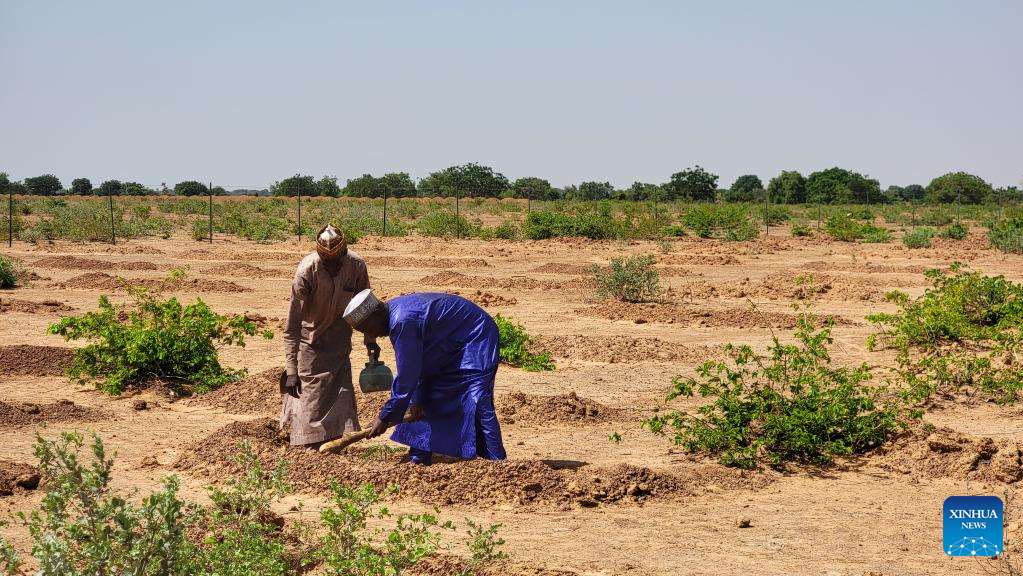Published: June 15,2023

A vast expanse of yellow sand came into sight as a convoy of three vehicles left behind crowded buildings in Kano city and drove further north into the arid landscape of north Nigeria’s Kano state, where the encroaching desert threatens the ecosystems and livelihood of local people.
Umar Danladi Dahiru, a passionate environmentalist, led the convoy to the site of a desertification control project in the state launched by the African Desertification Control Initiative (ADCI) in Nigeria, with support from the Chinese Academy of Sciences.
Dahiru pointed at piles of firewood on the roadside when the vehicles passed villages amid desert areas sparsely dotted with green trees, grass and crop field, saying they were for sale and that most people in Kano, especially in rural areas, still rely on wood for daily cooking and night lighting.
“The climate in Kano is dry, rainfall is scarce, and the land is fragile,” said Dahiru, director of the ADCI in Nigeria, a non-governmental organization. “But you cannot stop people from cutting down trees because they must cook and eat.”
He lamented that population growth, irrational land use and deforestation are among the factors that exacerbated land degradation and desertification in northern Nigeria.
Launched last year, the China-assisted project is part of the African Union-led Great Green Wall Initiative in Nigeria, sitting on about four hectares of sandy land fenced by barbed wire near the Gwarmai village in the Kunchi local government area of Kano.
Dahiru said the project is off to a good start in combating desertification and building a “green wall” in Kano and other Nigerian states bordering the Sahara Desert, the world’s largest desert.
“So the intention is that for research, for demonstration, for farmers to come and see what we are doing so that they can copy from us,” Dahiru said. He said four native tree species were planted in this area.
Dahiru said that the biggest challenge of the current project is the need for more water.
According to the 53-year-old environmentalist, the ADCI once drilled a water well nearby, but some time ago, a strong wind destroyed the water tower. The well is now silted and cannot be used, prompting the two maintenance personnel of the project to collect water from the village borehole several kilometers away every day to water the saplings.
Dahiru used to work for the agricultural ministry until he left more than a decade ago to devote himself to a career in desertification control because of concerns about threats to his homeland and his passion for environmental protection. He has traveled to China several times to attend training courses and seminars on combating desertification.
“I have been to China several times as a resource person for conferences,” Dahiru said, adding that “we have learned a lot from the Chinese expertise in terms of desertification control.”
He was fascinated by the innovative technology he discovered in China, which involved afforestation with brackish water in flowing sand, non-irrigated afforestation technology and vegetation restoration in activated sand.
Project maintainer Tanimu Lawal, a former employee of the environment ministry who left a year ago to join ADCI, now leads a volunteer recruited in Gwarmai village in the day-to-day maintenance of the project.
At dawn every morning, Lawal, who lives in another village not far from Gwarmai, comes to the project site together with the volunteer, watering the saplings and digging pits to plant trees.
Pointing to half-moon-shaped tree pits in front of him, he said that the shape of the tree pit is convenient for water storage and conducive to the growth of saplings.
In addition to water scarcity, Lawal said, the challenge of planting trees in desert areas includes mobilizing people to participate in the project.
“We mobilize the people and tell them how to care for the plants that we already planted. We are trying to plant this for controlling the desertification of the area,” he said, adding he admired the ability of the Chinese government and institutions to mobilize on major projects. He is also eager to go to China to learn about sand control technology.
Bala Muhammed, the volunteer, has family roots in Gwarmai village. For him, being directly involved in this project means a lot to the village, which currently has more than 50 families.
“We are grateful for this intervention that has been helpful to us. Honestly, we usually have issues with sand and wind. When it occurs, it often affects our houses, and in the worst case, it brings the houses down completely,” Muhammed said.
In recent years, he noted, some people in the village had moved to find a life in the city because they could not stand the increasingly severe sandstorms. But his family, he said, is attached to their homestead and has been hesitant to move for years. This project gives him a reason to stay.
Through his participation in the project, Muhammed has learned about some of China’s success stories in combating desertification. He hopes his persistent endeavors will someday transform his village into a lush oasis, even if it takes several decades or longer. ■

Two maintenance workers plant a sapling at the site of a desertification control project in the Kunchi local government area in Kano state, Nigeria, on June 5, 2023. The desertification control project was launched by the African Desertification Control Initiative (ADCI) in Nigeria, with support from the Chinese Academy of Sciences. (Xinhua/Guo Jun)
Source:Xinhua
 Africa -China Review Africa -China Cooperation and Transformation
Africa -China Review Africa -China Cooperation and Transformation
